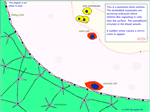Animations
 New! Directions for downloading, getting permission, and using animations
New! Directions for downloading, getting permission, and using animations
Click the links to view/download files (you may need to use the "save" command under the "file" menu of your browser).
REMODELING
Flash (316K)
| 
| This is an animation of the overall remodeling sequence. This one is not to scale but does show the details of origination as we know it. View Flash file on the physiology page.
|
|---|
| OSTEOPROTEGERIN | Flash (56K) | This is a small flash movie with a focus on OPG and the RANK-RANK-L interactions.
|
|---|
ONE BMU
Quicktime (412K)
GIF (432K)
Quicktime (776K)
GIF (852K)
Flash (684K)
| 
| This animation shows one BMU. It lasts about 11 seconds and represents about 6 months of real time. A micro-crack starts the process, the osteocytes (not shown here) sense damage and send signals into the marrow space. Preosteoclasts turn into multi-nucleated osteoclasts and start resorption, meanwhile preosteoblasts turn into osteoblasts and start forming osteoid (orange) which then mineralizes (green). For details go to physiology. The Flash movie shows the vascular compartment.
|
|---|
NORMAL TURNOVER
| Quicktime (664K)
Animated GIF (568K)
Quicktime (1.1 M)
Animated GIF (1 M)
Flash (728K)
| This animation shows a slice through a piece of bone about a millimeter long. It lasts 13 seconds and shows 30 months of "real time." The view is similar to the view seen under the microscope of a bone biopsy from a patient. The animation is derived from measurements of the bone surfaces and tetracyline labelling. There are about 10 BMU's in this view, each at a different stage. The bone formation rate in this movie is a bit above average, but within the normal range. The shades of green represent the mineralization density: newly formed bone is not very dense (pale green) and older bone is denser (dark green). This is not seen well on standard biopsies but can be determined with backscattered electron micrography.
|
|---|
MENOPAUSE
| Quicktime (608K)
Animated GIF (508K)
Quicktime (1 M)
Animated GIF (1 M)
| This animation starts the same place as the one showing normal turnover. The initial bone volume is 25%. The movie then shows what happens with estrogen deficiency. The resorption cavities are deeper and they occur more frequently. With these small changes, the individual BMU does not seem very different. But there are more BMU's and the trabeculae become perforated. They lose strength and have microfractures with microcallus formation. By 30 months the bone volume has decreased to 22%. Note that the width of the individual trabecula are normal. (Go to estrogen).
|
|---|
| BISPHOSPHONATES
| Quicktime (884K)
Animated GIF (864K)
Quicktime (1.8 M)
Animated GIF (1.8 M)
| This animation starts after the estrogen deficiency. The first 6 months show high turnover; then the little blue diamonds representing a bisphosphonate start to attach to the bone; resorption stops suddenly and formation stops after a few months. The bone continues to become more mineralized (darker), and only a few BMU's are still active. The very low bone formation and increased mineralization have been reported from studies in humans. The accumulation of micro-cracks has been seen in dogs but not humans, but long-term biopsy data on humans has not been published. (Go to bisphosphonates).
|
|---|
RALOXIFENE
| Quicktime (3MB)
Animated GIF (2.2MB)
Quicktime (1.9MB)
Animated GIF (1.3MB)
Flash movie (2.2MB)
| This movie shows the effect of raloxifene in women with osteoporosis. Note that the beginning bone volume is already lower than in the other examples. The areas and surfaces correspond to the actual measurements made by our lab. Go to SERMs).
|
|---|
| PTH (intermittent)
| Quicktime (1.5MB)
Animated GIF (2.2MB)
| These results from intermittent PTH are compiled from several small human studies of bone histomorphomety following PTH. Some of the results are not consistent so these illustrations may be altered when larger studies become available. We do know the bone formation increases and the mineralization density decreases. Go to the new page about PTH.
|
|---|
| PTH, showing cortex
| Quicktime (1MB)
| Much of the effect of PTH is seen on the cortex, so here is a brief movie showing this.
|
|---|
 NEW! NEW!
Paget's disease
| Flash (3MB) | This lively animation shows what very high bone turnover looks like. More about Paget's disease is on the new ASBMR Bone curriculum website
|
Updated 3/30/07



 NEW!
NEW! 